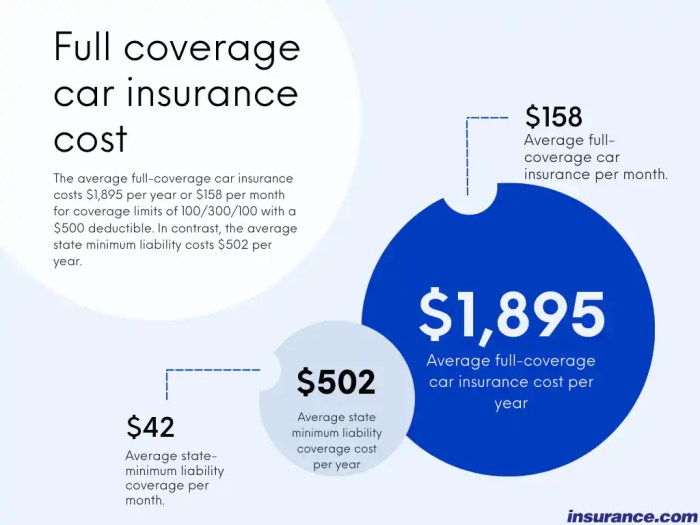Navigating the world of car insurance in Texas can feel like driving through a maze. With a wide array of providers and coverage options, finding the best full coverage policy that fits your individual needs and budget requires careful consideration. This guide unravels the complexities of Texas car insurance, offering a clear path to securing comprehensive protection without overspending. We’ll explore minimum requirements, cost-influencing factors, top insurers, and strategies for securing the best possible policy for your circumstances.
From understanding liability limits and the nuances of collision and comprehensive coverage to comparing quotes and negotiating premiums, we’ll equip you with the knowledge to make informed decisions. We’ll also address common pitfalls and provide practical tips for navigating the claims process should the unfortunate happen. Ultimately, our aim is to empower you to confidently choose the full coverage car insurance that provides the peace of mind you deserve on Texas roads.
Understanding Texas Car Insurance Requirements

Driving in Texas requires understanding the state’s car insurance laws to ensure you’re legally protected and financially responsible. Failure to comply can lead to significant penalties, including fines, license suspension, and even vehicle impoundment. This section details the minimum requirements and explores additional coverage options to enhance your protection.
Texas Minimum Car Insurance Requirements
Texas mandates minimum liability coverage for all drivers. This means you must carry insurance that covers the costs associated with injuries or damages you cause to others in an accident. The minimum requirement is 30/60/25. This translates to $30,000 in bodily injury liability coverage per person injured, $60,000 in total bodily injury liability coverage per accident, and $25,000 in property damage liability coverage per accident. It’s crucial to understand that these limits represent the maximum amount your insurance company will pay for claims resulting from your at-fault accidents. If your liability exceeds these amounts, you would be personally responsible for the difference.
Liability Coverage Limits and Implications
The implications of insufficient liability coverage are substantial. Imagine you cause an accident resulting in serious injuries to multiple people. If your injuries cost more than the $60,000 limit, you could be sued for the remaining amount. This could lead to significant financial hardship, including wage garnishment, the seizure of assets, and potentially bankruptcy. Therefore, carrying higher liability limits than the minimum is strongly recommended. Many insurers offer options such as 100/300/100 or even higher limits for increased protection. The cost difference for increased coverage is often surprisingly small compared to the potential financial devastation of an underinsured accident.
Types of Car Insurance Coverage in Texas
Beyond the mandatory liability coverage, several other types of insurance provide additional protection. Collision coverage pays for repairs to your vehicle resulting from an accident, regardless of fault. Comprehensive coverage protects against damage caused by events other than collisions, such as theft, vandalism, fire, or hail. Uninsured/Underinsured Motorist (UM/UIM) coverage protects you if you’re involved in an accident with an uninsured or underinsured driver. Medical payments coverage helps pay for medical bills for you and your passengers, regardless of fault. Personal Injury Protection (PIP) coverage, while not mandatory in Texas, covers medical expenses and lost wages for you and your passengers.
Minimum vs. Recommended Coverage Levels
The following table compares the minimum required coverage with recommended coverage levels. Note that these are recommendations and individual needs may vary. Consult with an insurance agent to determine the best coverage for your specific circumstances.
| Coverage Type | Minimum Required | Recommended | Description |
|---|---|---|---|
| Bodily Injury Liability (per person) | $30,000 | $100,000 or more | Covers injuries you cause to others. |
| Bodily Injury Liability (per accident) | $60,000 | $300,000 or more | Covers total injuries you cause per accident. |
| Property Damage Liability | $25,000 | $100,000 or more | Covers damage you cause to others’ property. |
| Collision | Not Required | Recommended | Covers damage to your vehicle in an accident. |
| Comprehensive | Not Required | Recommended | Covers damage to your vehicle from non-collision events. |
| Uninsured/Underinsured Motorist | Not Required | Strongly Recommended | Protects you if hit by an uninsured or underinsured driver. |
Finding the Best Full Coverage Policy for Individual Needs

Choosing the right full coverage car insurance policy in Texas requires careful consideration of your individual circumstances. The ideal level of coverage isn’t a one-size-fits-all solution; it depends on your assets, risk tolerance, and the value of your vehicle. Understanding these factors is crucial to securing a policy that provides adequate protection without unnecessary expense.
Determining the appropriate level of coverage involves assessing your personal assets and risk tolerance. Consider the value of your car, your other assets (home, investments), and your financial capacity to absorb potential losses. A higher risk tolerance might lead you to opt for higher liability limits, while a lower tolerance might suggest prioritizing comprehensive and collision coverage. For example, someone with significant assets might choose higher liability limits to protect themselves from substantial lawsuits, while someone with limited assets might focus on ensuring their vehicle is adequately covered for repairs or replacement.
Coverage Levels and Personal Assets
The amount of liability coverage you need is directly related to the value of your assets. Liability coverage protects you financially if you cause an accident that injures someone or damages their property. Higher liability limits offer greater protection, but also come with higher premiums. Consider the potential costs of medical bills, legal fees, and property damage in a serious accident. A minimum liability policy might not be sufficient in a high-damage scenario. Similarly, the value of your vehicle directly impacts the decision regarding collision and comprehensive coverage. Comprehensive coverage protects against damage not caused by collisions (like hail or theft), while collision covers damage from accidents. The cost to replace or repair your vehicle should be a key factor in choosing these coverages.
Comparing Quotes from Multiple Insurers
Obtaining quotes from multiple insurers is essential to finding the best value for your money. Different insurers use different rating factors, leading to variations in premiums even for similar coverage levels. Comparing at least three to five quotes allows you to identify the most competitive options and ensure you aren’t overpaying. Don’t just focus on the premium; compare the coverage details as well, ensuring you’re comparing apples to apples.
Obtaining Car Insurance Quotes
Obtaining car insurance quotes is a straightforward process. You can obtain quotes online through the insurers’ websites, a process that typically involves providing basic information about yourself, your vehicle, and your desired coverage. Alternatively, you can work with an independent insurance agent who can compare quotes from multiple insurers on your behalf. Agents can provide personalized advice and help you navigate the complexities of insurance policies. Both online and agent-based methods offer convenience, but online quotes provide immediate results, while agents offer personalized guidance.
Negotiating Lower Insurance Premiums
Several strategies can help you negotiate lower insurance premiums. Maintaining a good driving record is paramount; accidents and traffic violations significantly impact your premiums. Consider bundling your car insurance with other types of insurance, such as homeowners or renters insurance, to potentially qualify for discounts. Increasing your deductible can lower your premiums, but remember that this means you’ll pay more out-of-pocket in the event of a claim. Exploring discounts for safety features in your car (anti-theft devices, airbags), completing a defensive driving course, or paying your premium in full annually instead of monthly can also lead to savings.
Illustrative Examples of Full Coverage Policies
Choosing the right full coverage car insurance policy in Texas can feel overwhelming given the variety of options available. Understanding the different levels of coverage and their associated costs is crucial to making an informed decision. The following examples illustrate three distinct full coverage policies, highlighting the trade-offs between cost and comprehensive protection.
Example Policy 1: The Budget-Conscious Plan
This policy prioritizes affordability while still providing the essential elements of full coverage. It offers liability coverage of $30,000 per person and $60,000 per accident, which is the state minimum. Collision and comprehensive coverage have higher deductibles, typically $1,000 each. Uninsured/underinsured motorist coverage is also included at the state minimum. This plan might include features like roadside assistance, but likely excludes extras like rental car reimbursement.
The potential cost savings are significant, making it an attractive option for drivers on a tight budget. However, the higher deductibles mean a larger out-of-pocket expense in the event of an accident. For example, if the driver is at fault in a collision resulting in $3,000 in damages, they would pay the $1,000 deductible and the insurance company would cover the remaining $2,000. This plan is best suited for drivers with older vehicles or those comfortable with a higher risk tolerance.
Example Policy 2: The Balanced Approach
This policy offers a balance between cost and comprehensive coverage. It provides liability coverage of $100,000 per person and $300,000 per accident, offering substantially greater protection than the minimum requirements. Collision and comprehensive coverage feature a $500 deductible each, significantly reducing the out-of-pocket expense compared to the budget-conscious plan. Uninsured/underinsured motorist coverage is also higher than the state minimum. Additional benefits, such as rental car reimbursement for a limited period, might be included.
The cost will be higher than the budget-conscious plan, but the increased liability coverage offers peace of mind in the event of a serious accident. The lower deductibles mean lower out-of-pocket costs in the event of a claim. For instance, in the same $3,000 collision scenario, the driver would only pay $500, with the insurance company covering the remaining $2,500. This option provides a solid level of protection without breaking the bank, suitable for drivers who value both affordability and comprehensive coverage.
Example Policy 3: The Premium Protection Plan
This policy provides the most comprehensive coverage available. Liability coverage is significantly higher, perhaps $250,000 per person and $500,000 per accident. Collision and comprehensive coverage often have lower deductibles, such as $250 or even $0. Uninsured/underinsured motorist coverage is maximized. Numerous additional benefits are typically included, such as rental car reimbursement, towing, and possibly even accident forgiveness.
The cost is significantly higher than the other two examples, but this policy provides the ultimate peace of mind. The low deductibles minimize out-of-pocket expenses, and the high liability coverage protects against potentially devastating financial consequences in the event of a serious accident. This plan is ideal for drivers with newer, more expensive vehicles or those seeking maximum protection regardless of cost. For a driver involved in a major accident causing $10,000 in damages, a $250 deductible would represent a substantially lower out-of-pocket cost compared to the higher deductibles of other plans.
Ending Remarks

Securing the best full coverage car insurance in Texas is a crucial step in responsible vehicle ownership. By understanding Texas’s insurance requirements, considering the factors that influence costs, and carefully comparing policies from reputable insurers, you can find a plan that offers comprehensive protection tailored to your specific needs and financial situation. Remember to always read your policy thoroughly, understand its limitations, and maintain open communication with your insurer. Driving safely and proactively managing your insurance coverage are key to ensuring a smooth and secure driving experience in the Lone Star State.
Expert Answers
What is the difference between liability and full coverage insurance?
Liability insurance covers damages you cause to others, while full coverage adds collision and comprehensive coverage, protecting your vehicle from damage regardless of fault.
How often can I expect my insurance rates to change?
Rates can change annually, or even more frequently, based on factors like driving record, claims history, and changes in your personal information.
Can I get my car insurance cancelled?
Yes, your insurance can be cancelled for various reasons, including non-payment, fraudulent activity, or repeated violations.
What should I do if I’m involved in an accident?
Prioritize safety, call emergency services if needed, exchange information with other parties, and contact your insurance company as soon as possible.